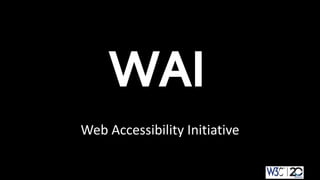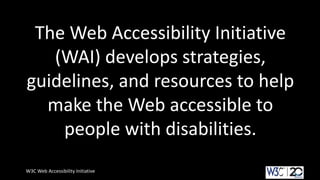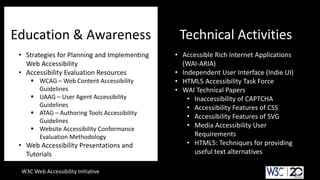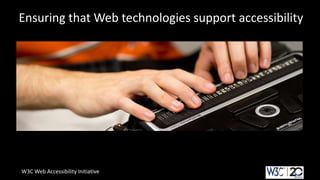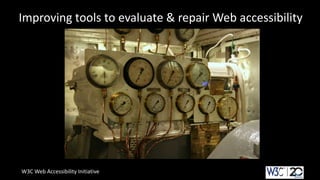Wai Overview
- 1. WAI Web Accessibility Initiative
- 2. The Web Accessibility Initiative (WAI) develops strategies, guidelines, and resources to help make the Web accessible to people with disabilities. W3C Web Accessibility Initiative
- 3. WAI activities at the W3C 1. Ensuring that Web technologies support accessibility 2. Developing guidelines for accessibility 3. Improving tools to evaluate & repair Web accessibility 4. Developing materials for education and outreach 5. Coordinating with research and development W3C Web Accessibility Initiative
- 4. Education & Awareness ? Strategies for Planning and Implementing Web Accessibility ? Accessibility Evaluation Resources ? WCAG – Web Content Accessibility Guidelines ? UAAG – User Agent Accessibility Guidelines ? ATAG – Authoring Tools Accessibility Guidelines ? Website Accessibility Conformance Evaluation Methodology ? Web Accessibility Presentations and Tutorials W3C Web Accessibility Initiative Technical Activities ? Accessible Rich Internet Applications (WAI-ARIA) ? Independent User Interface (Indie UI) ? HTML5 Accessibility Task Force ? WAI Technical Papers ? Inaccessibility of CAPTCHA ? Accessibility Features of CSS ? Accessibility Features of SVG ? Media Accessibility User Requirements ? HTML5: Techniques for providing useful text alternatives
- 5. W3C Web Accessibility Initiative
- 6. Ensuring that Web technologies support accessibility W3C Web Accessibility Initiative
- 7. Developing guidelines for accessibility W3C Web Accessibility Initiative
- 8. Developing guidelines for accessibility W3C Web Accessibility Initiative WCAG – Web Content Accessibility Guidelines - http://www.w3.org/TR/WCAG20/ ATAG – Authoring Tools Accessibility Guidelines - http://www.w3.org/TR/ATAG20/ UAAG – User Agent Accessibility Guidelines - http://www.w3.org/TR/UAAG20/
- 9. Improving tools to evaluate & repair Web accessibility W3C Web Accessibility Initiative
- 10. Developing materials for education and outreach W3C Web Accessibility Initiative
- 11. Coordinating with research and development W3C Web Accessibility Initiative
- 12. Activities of Interest W3C Web Accessibility Initiative
- 13. Getting Involved WAI IG mailing list Review and comment ongoing work efforts Contribute Techniques to WCAG Join a Community Group * Accessible Infographics * Accessible SVG * Automated WCAG Monitoring * CSS Accessibility * Color blindness accessibility * Media Resource In-band Tracks * WAI-Engage: Web Accessibility W3C Web Accessibility Initiative
- 14. Getting Involved WAI IG mailing list Review and comment ongoing work efforts Contribute Techniques to WCAG Join a Community Group * Accessible Infographics * Accessible SVG * Automated WCAG Monitoring * CSS Accessibility * Color blindness accessibility * Media Resource In-band Tracks * WAI-Engage: Web Accessibility W3C Web Accessibility Initiative
- 15. THANK YOU QUESTIONS? W3C Web Accessibility Initiative Contact Me: John Foliot Web: http://john.foliot.ca Email: john@foliot.ca Twitter: @johnfoliot
- 16. Credits and Acknowledgements: ? W3C 20th Anniversary logo: http://www.w3.org/20/img/w3c20_small.png ? Yin Yang (Taijitu) symbol: http://commons.wikimedia.org/wiki/File:Yin_yang.svg ? Braille Output device: https://accessibility.temple.edu/sites/accessibility/files/a ccessibility-homepage-slide-image.jpg ? HMS Belfast - Boiler room – Gauges: http://commons.wikimedia.org/wiki/File:HMS_Belfast_- _Boiler_room_-_Gauges_1.jpg ? Bart Simpson Chalkboard Generator : http://www.addletters.com/pictures/bart-simpson-generator/ 5217353.htm#.VHugIMm9Y4o ? R&D Photo Collage: http://www.w3.org/2008/10/w3c-tpac.jpg ? Participate (Hands): http://driverlayer.com/img/participate/145/any W3C Web Accessibility Initiative This presentation is published and licensed under a Creative Commons Attribution 3.0 Unported License. This presentation is based upon materials from the Web Accessibility Initiative (WAI) Copyright ? W3C? (MIT, ERCIM, Keio) where applicable. Used with permission. 狠狠撸s posted at: http://www.slideshare.net/johnfoliot/waioverview
Editor's Notes
- #7: The Protocols and Formats Working Group: Ensures that W3C technologies support Web accessibility Reviews W3C specifications at or before Last Call Working Draft stage many technical experts from W3C working groups participate Produces requirements statements and review comments
- #8: WCAG – Web Content Accessibility Guidelines - http://www.w3.org/TR/WCAG20/ ATAG – Authoring Tools Accessibility Guidelines - http://www.w3.org/TR/ATAG20/ UAAG – User Agent Accessibility Guidelines - http://www.w3.org/TR/UAAG20/
- #9: W3C Recommendation (REC): A W3C Recommendation is a specification or set of guidelines or requirements that, after extensive consensus-building, has received the endorsement of W3C Members and the Director. W3C recommends the wide deployment of its Recommendations as standards for the Web. The W3C Royalty-Free IPR licenses granted under the Patent Policy apply to W3C Recommendations. Proposed Recommendation: A Proposed Recommendation is a document that has been accepted by the W3C Director as of sufficient quality to become a W3C Recommendation. This phase establishes a deadline for the Advisory Committee review which begins with Candidate Recommendation. Substantive changes must not be made to a Proposed Recommendation except by publishing a new Working Draft or Candidate Recommendation. Candidate Recommendation (CR): A Candidate Recommendation is a document that satisfies the Working Group's technical requirements, and has already received wide review. W3C publishes a Candidate Recommendation to * signal to the wider community that a final review should be done * gather implementation experience * begin formal review by the Advisory Committee, who may recommend that the document be published as a W3C Recommendation, returned to the Working Group for further work, or abandoned. * Provide an exclusion opportunity as per the W3C Patent Policy [PUB33]. A Candidate Recommendation under this process corresponds to the "Last Call Working Draft" discussed in the Patent Policy. Note: Candidate Recommendations are expected to be acceptable as Recommendations. Announcement of a different next step should include the reasons why the change in expectations comes at so late a stage. Working Draft (WD): A Working Draft is a document that W3C has published for review by the community, including W3C Members, the public, and other technical organizations. Some, but not all, Working Drafts are meant to advance to Recommendation; see the document status section of a Working Draft for the group's expectations. Any Working Draft not, or no longer, intended to advance to Recommendation should be published as a Working Group Note. Working Drafts do not necessarily represent a consensus of the Working Group, and do not imply any endorsement by W3C or its members beyond agreement to work on a general area of technology. Working Group Note, Interest Group Note (NOTE): A Working Group Note or Interest Group Note is published by a chartered Working Group or Interest Group to provide a stable reference for a useful document that is not intended to be a formal standard, or to document work that was abandoned without producing a Recommendation. Rescinded Recommendation: A Rescinded Recommendation is an entire Recommendation that W3C no longer endorses. See also clause 10 of the licensing requirements for W3C Recommendations in section 5 of the W3C Patent Policy [PUB33].
- #10: Website Accessibility Conformance Evaluation Methodology (WCAG-EM) 1.0 – http://www.w3.org/TR/WCAG-EM/ (Working Group Note) Web Accessibility Evaluation Tools List - http://www.w3.org/WAI/ER/tools/ (W3C does not endorse specific products. Information on this page is provided by vendors and others.) Template(s) for Accessibility Evaluation Reports - http://www.w3.org/WAI/eval/template.html
- #11: Techniques documents & Tutorials for WCAG, UAAG, ATAG Web Accessibility Presentations and Tutorials * Web Accessibility Presentations * Presentation & Workshop Outlines WAI-IG Mailing list Policy Resources
- #12: Protocols and Formats Working Group Coordination with: WAI-ARIA Working Group HTML(5) Working Group Indie UI Working Group Joint Task Force WCAG Techniques Working Group Canvas 2D (hit regions) Education and Outreach Working Group SVG Working Group Evaluation Tools Working Group Web Applications (WebApps) Working Group Cognitive & Learning Disabilities Accessibility Task Force Informal coordination with: Web and TV Interest Group Digital Publishing Interest Group Web Payments Interest Group Timed-Text Working Group
- #13: WAI-ARIA 1.1 – Recommendation WAI-ARIA 1.1 – Working Draft Indie UI – Events 1.0 & Context 1.0 – Working Drafts The purpose of Indie Ui is to make it easier for web applications to work in a wide range of contexts across different devices, different assistive technologies and different user needs. IndieUI User Context is to provide authorized web applications access to information about a user's relevant settings and preferences. IndieUI Events is an abstraction between physical, device-specific user interaction events and inferred user intent such as scrolling or changing values. (eg: zoomrequest) https://dvcs.w3.org/hg/IndieUI/raw-file/default/src/indie-ui-events.html Image Description Extension (longdesc) – Candidate Recommendation – returns @longdesc to HTML5
- #14: WAI IG mailing list Review and comment ongoing work efforts Contribute Techniques to WCAG Join a Community Group * Accessible Infographics * Accessible SVG * Automated WCAG Monitoring * CSS Accessibility * Color blindness accessibility * Media Resource In-band Tracks * WAI-Engage: Web Accessibility
- #15: WAI IG mailing list Review and comment ongoing work efforts Contribute Techniques to WCAG Join a Community Group * Accessible Infographics * Accessible SVG * Automated WCAG Monitoring * CSS Accessibility * Color blindness accessibility * Media Resource In-band Tracks * WAI-Engage: Web Accessibility

